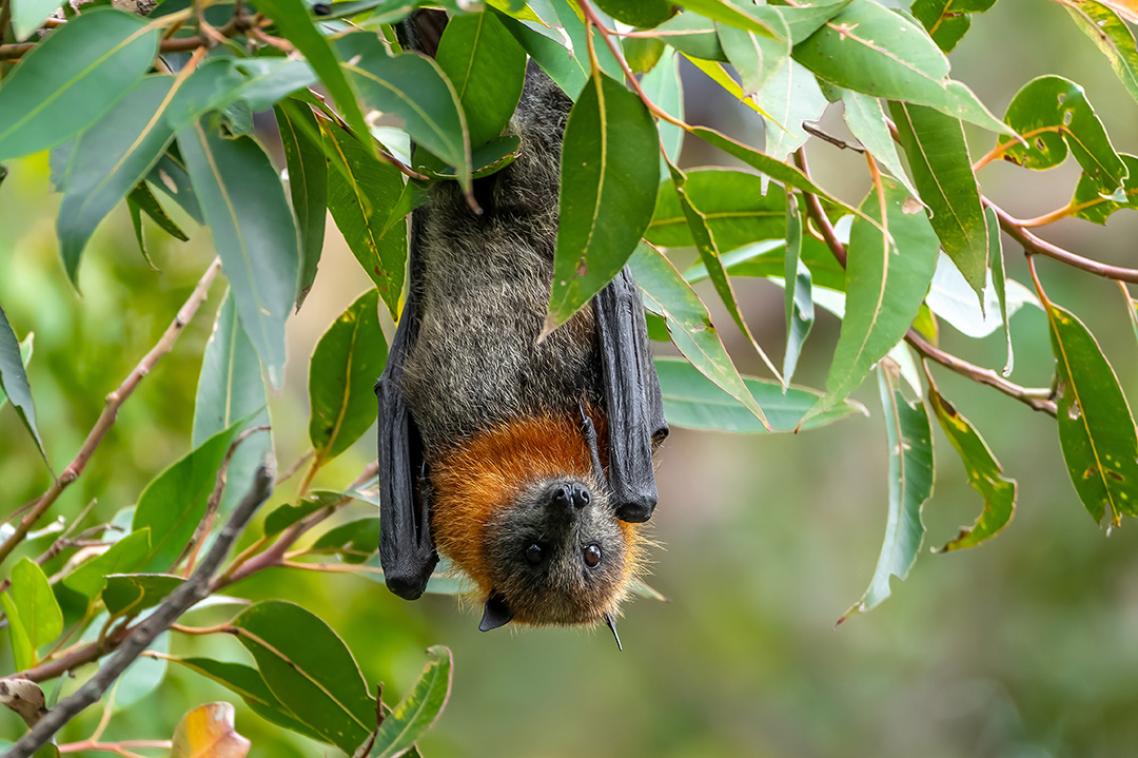
Australian bats can also carry viruses that are dangerous to humans.
(Photo credit: Leandro/Adobe Stock. )
Key points
- Fewer than 1 per cent of wild bats have lyssavirus but if humans become infected, cases are almost always fatal.
- There is no way to tell if a bat is infected with lyssavirus by looking at it.
- Australian bat lyssavirus belongs to a group of viruses that includes the genetically similar rabies.
There are up to 81 native bat species in Australia, from microbats to larger fruit bats and flying foxes.
Bats are valuable to the environment – flying foxes are key pollinators of eucalypt trees that koalas, gliders and possums rely on, while the microbat’s diet of mostly insects helps control pest species.
But Australian bats can also carry viruses that are dangerous to humans.
These include Hendra virus, which must first infect a horse before it can be passed to a human, and Australian bat lyssavirus (ABLV), which has so far only been transmitted directly to humans from bats.
Fewer than 1 per cent of wild bats have lyssavirus but if humans become infected, cases are almost always fatal.
There have been 4 documented cases of ABLV in humans since it was first identified in 1996, including a recent case in New South Wales.
There have been 2 ABLV cases in horses, but no reported cases in dogs, cats or other mammal species.
ABLV belongs to a group of viruses that includes the genetically similar rabies lyssavirus.
But rabies is better at jumping to new species and causes up to 60,000 human deaths per year globally, mostly from infected dogs.
How is Australian bat lyssavirus spread?
There is no way to tell if a bat is infected with lyssavirus by looking at it.
But the disease makes the bat sick, so is more common in bats that are on the ground or behaving abnormally, like being active in the daytime.
All lyssaviruses are transmitted the same way – usually when the saliva of an infected animal enters a wound or opening in the skin through a bite or scratch or comes into contact with a mucous membrane like eyes, mouth or the inside of the nose.
Nervous system tissues like the brain or spinal cord can also act as a source of transmission, but blood, urine and faeces are not considered infectious.
What happens if you get lyssavirus?
When the virus enters the body it multiplies and travels along the nerves towards the brain, where it triggers a reaction preventing antibodies entering the brain to fight it.
Symptoms include fever, headache, pain and tingling or itching at the exposure site.
Rabies cases show this can take anywhere from 5 days to several years after exposure.
All lyssaviruses cause the same illness and are almost always fatal if symptoms appear.
Of the millions of symptomatic lyssavirus cases that have been documented in humans, most involving rabies, there have only been a handful of survivors.
If exposed, what do I do?
- Wash the area thoroughly with soap and water for at least 15 minutes and apply an antiseptic like Betadine (povidone-iodine).
- Seek medical attention immediately. Rabies vaccines and immunoglobulin are usually very effective at preventing infection – but only if given before the virus reaches the brain and only if the full course of treatment is completed.
- Ideally, treatment should be started within 48 hours of exposure. The first 3 human cases of ABLV did not receive treatment before developing symptoms.
- Scratches, even minor ones that do not bleed, can still lead to infection because animals often lick their claws, allowing virus to collect there.
- Any direct contact between a bat’s claws or teeth and your skin is considered very high risk.
What can we do to prevent lyssavirus?
Avoid any direct contact with bats. Bats with lyssavirus are also found outside Australia - in the Americas, Europe, Africa and Asia.
If you find a bat, do not approach it. Call a bat rescue organization like WIRES and await their instruction. Any animal will likely try to protect itself or escape if it feels threatened.
Remove barbed wire from your property and ensure fruit trees are properly netted to prevent bats getting trapped.
Secure pets at night to prevent them encountering a bat. If your pet is exposed, rabies vaccination from a veterinarian is recommended as soon as possible as a precaution.
Remember:
- Bats can bite through gloves, towels and blankets.
- Unlike birds, bats cannot take off from the ground so they may try to climb up whatever they can.
- Flying foxes can have wingspans of around 1 metre.
Why can’t we just get rid of bats?
Because our ecosystems rely on them. Trying to relocate bats, especially flying foxes, also takes a lot of money and effort and usually just lands them in someone else’s backyard.
The best thing that we can do is try to create space for bats to minimise interaction with them.
It’s better for them and for us.
Topics
Related articles

UQ’s Poche Centre celebrates a decade of work to help close the gap in Indigenous health

Sponge-like gold particles could upgrade ovarian cancer diagnostics
Media contact
UQ Communications
communications@uq.edu.au
+61 429 056 139
